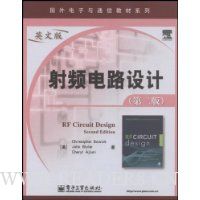基本信息·出版社:电子工业出版社 ·页码:346 页 ·出版日期:2008年09月 ·ISBN:7121072726/9787121072727 ·条形码:9787121072727 ·版本:第2版 · ...
| 商家名称 |
信用等级 |
购买信息 |
订购本书 |
|
|
 |
射频电路设计(第2版)(英文版) |
 |
|
 |
射频电路设计(第2版)(英文版) |
 |

基本信息·出版社:电子工业出版社
·页码:346 页
·出版日期:2008年09月
·ISBN:7121072726/9787121072727
·条形码:9787121072727
·版本:第2版
·装帧:平装
·开本:16
·正文语种:英语
·丛书名:国外电子与通信教材系列
·外文书名:RF Circuit Design
内容简介 《射频电路设计》第一版写于1982年并多次重印,是一本经典的射频电路书籍。新版加强了无线技术方面的阐述,新增了关于射频前端设计与射频设计工具的两章内容,还包含了集成电路和系统级设计方面的内容。《射频电路设计》内容包括电路元件、谐振电路、滤波器设计、阻抗匹配、射频晶体管、小信号射频放大器设计、射频(大信号)功率放大器设计、射频前端电路设计和射频软件工具等。该书内容精炼,深入浅出,书中包括许多详细的设计实例,非常适合有一定电路基础的初学者作为实践指南。 《射频电路设计》适合射频与微波技术工程师、无线通信工程技术人员和通信网技术人员阅读,也可供相关科研工作者及工程技术人员参考。
目录 Chapter l Components and Systems
1.1 WIRE
1.1.1 Skin Effect
1.1.2 Straight-Wire Inductors
1.2 RESISTORS
1.2.1 Resistor Equivalent Circuit
1.3 CAPACITORS
1.3.1 Parallel-Plate Capacitor
1.3.2 Real-World Capacitors
1.3.3 Capacitor Types
1.4 INDUCTORS
1.4.1 Real-World Inductors
1.4.2 Single-Layer Air-Core Inductor Design
1.4.3 Magnetic-Core Materials
1.5 TOR01DS
1.5.1 Core Characteristics
1.5.2 Powdered Iron vs. Ferrite
1.6 TOROIDAL INDUCTOR DESIGN
1.7 PRACTICAL WINDING HINTS
Chapter 2 Resonant Circui
2.1 SOME DEFINITIONS
2.2 RESONANCE (LOSSLESS COMPONENTS)
2,3 LOADED Q
2.3.1 Effect of R, and RL on the Loaded Q
2.3.2 The Effect of Component Q on Loaded Q
2.4 INSERTION LOSS
2.5 IMPEDANCE TRANSFORMATION
2.6 COUPLING OF RESONANT CIRCUITS
2.6.1 Capacitive Coupling
2.6.2 Inductive Coupling
2.6.3 Active Coupling
2.7 SUMMARY
Chapter 3 Filter Design
3.1 BACKGROUND
3.2 MODERN FILTER DESIGN
3.3 NORMALIZATION AND THE LOW-PASS PROTOTYPE
3.4 FILTER TYPES
3.4.1 The Butterworth Response
3.4.2 The Chebyshev Response
3.4.3 The Bessel Filter
3.5 FREQUENCY AND IMPEDANCE SCALING
3.6 HIGH-PASS FILTER DESIGN
3.7 THE DUAL NETWORK
3.8 BANDPASS FILTER DESIGN
3.9 SUMMARY OF THE BANDPASS FILTER DESIGN PROCEDURE.
3.10 BAND-REJECTION FILTER DESIGN
3.11 THE EFFECTS OF FINITE Q
Chapter 4 Impedance Matching
4. l BACKGROUND
4.2 THE L NETWORK
4.3 DEALING WITH COMPLEX LOADS
4.4 THREE-ELEMENT MATCHING
4.4.1 The Pi Network
4.4.2 The T network
4.5 LOW-Q or WIDEBAND MATCHING NETWORKS
4.6 THE SMITH CHART
4.6.1 Smith Chart Construction
4.6.2 Basic Smith Chart Tips
4.6.3 Plotting Impedance Values
4.6.4 Impedance Manipulation on the Chart
4.6.5 Conversion of Impedance to Admittance
4.6.6 Admittance Manipulation on the Chart
4.7 IMPEDANCE MATCHING ON THE SMITH CHART
4.7.1 Two-Element Matching
4.7.2 Three-Element Matching
4.7.3 Multi-Element Matching
4.8 SOFTWARE DESIGN TOOLS
4.8.1 Smith Chart Tools
4.8.2 Integrated Design Tools
4.9 SUMMARY
Chapter 5 The Transistor at Radio Frequencies
5.1 RF TRANSISTOR MATERIALS
5.2 THE TRANSISTOR EQUIVALENT CIRCUIT
5.2.1 Input Impedance
5.2.2 0utput Impedance
5.2.3 Feedback Characteristics
5.2.4 Gain
5.2.5 Transistor as a Switch
5.2.6 MEMs as a Switch
5.3 Y PARAMETERS
5.3.1 The Transistor as a Two-Port Network
5.3.2 Two-Port Y Parameters
5.4 S PARAMETERS
5.4.1 Transmission Line Background
5.4.2 S Parameters and the Two-Port Network
5.5 UNDERSTANDING RF TRANSISTOR DATA SHEETS
5.6 SUMMARY
Chapter 6 Small-Signal RF Amplifier Design
Chapter 7 RF(Large Signal)Power Amplifiers
Chapter 8 RF Front-End Design
Chapter 9 RF Design Tools
Appendix A RF And Antennas
Appendix B Vector Algebra
Bibliography
……
序言 2008年7月间,电子工业出版社的领导同志邀请各高校十几位通信领域方面的老师,商量引进国外教材问题。与会同志对出版社提出的计划十分赞同,大家认为,这对我国通信事业、特别是对高等院校通信学科的教学工作会很有好处。
教材建设是高校教学建设的主要内容之一。编写、出版一本好的教材,意味着开设了一门好的课程,甚至可能预示着一个崭新学科的诞生。20世纪40年代MIT林肯实验室出版的一套28本雷达丛书,对近代电子学科、特别是对雷达技术的推动作用,就是一个很好的例子。我国领导部门对教材建设一直非常重视。20世纪80年代,在原教委教材编审委员会的领导下,汇集了高等院校几百位富有教学经验的专家,编写、出版了一大批教材;很多院校还根据学校的特点和需要,陆续编写了大量的讲义和参考书。这些教材对高校的教学工作发挥了极好的作用。近年来,随着教学改革不断深入和科学技术的飞速进步,有的教材内容已比较陈旧、落后,难以适应教学的要求,特别是在电子学和通信技术发展神速、可以讲是日新月异的今天,如何适应这种情况,更是一个必须认真考虑的问题。解决这个问题,除了依靠高校的老师和专家撰写新的符合要求的教科书外,引进和出版一些国外优秀电子与通信教材,尤其是有选择地引进一批英文原版教材,是会有好处的。
文摘 Components, those bits and pieces which make up a radio frequency (RF) circuit, seem at times to be taken for granted. A capacitor is, after all, a capacitor--isn't it? A 1-megohm resistor presents an impedance of at least l megohm—doesn't it? The reactance of an inductor always increases with frequency, right? Well, as we shall see later in this discussion, things aren't always as they seem. Capacitors at certain frequencies may not be capacitors at all, but may look inductive, while inductors may look like capacitors, and resistors may tend to be a little of both. In this chapter, we will discuss the properties of resistors, capacitors, and inductors at radio frequencies as they relate to circuit design. But, first, let's take a look at the most simple component of any system and examine its problems at radiofrequencies.




